 |
The Deutsche Bundes- Bahn started a series of trials using the Inter-City-Experimental (also called ICE-V) test train. Pictures on the left I at the test run! |
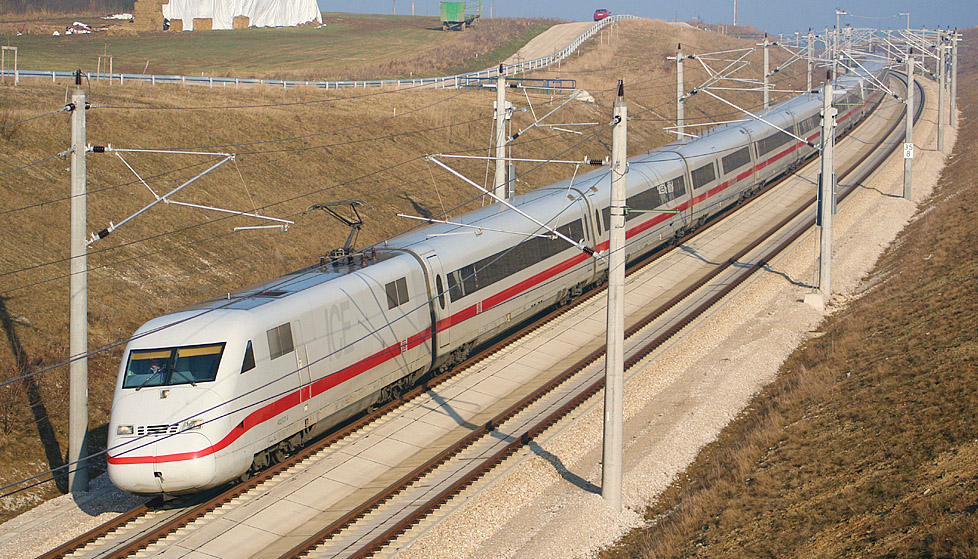
-Builders:several German companies -ABB -AEG -Henschel -Krauss-Maffei -Krupp -Siemens
->Units built: 60
->Units in use: 59, one unit lost in accident
->Maximum design speed: 280 km/h (174 mph)
->Power: 9600 kW(2 x 4800 kW) (13 052 Hp)
->Electricity: 15 kV 16,7 Hz
->Unit numbers: 101 - 120, 152 - 190
->Loco unit numbers: 401 001 - 019, 051 - 090, 501- 520, 552 - 590
->Electrical systems: Asynchronous
->Unitlength: 410,7 m (with 14 cars)
->Height: 3,84 m, restaurantcar 4,3 m
->Width 3,02 m
->Windfactor: 0,17 at front, very low!
->Trailers: 14,
-class 801: 1st class, 53 seats, 2 + 1 seating, toilet
-class 801.8: 1st class, 41 seats, telephone booth, toilet
-class 802: 2nd class, 71 seats, 2 toilets
-class 802.9: 2nd class (car 7), ?? seats
-class 803: servicecar, 35 second class seats, 2 wheelchair places, access free bathroom, baby chancing room, meetingroom
-class 804: restaurant car, places for40 seated customers and 10standing customers, the roof is higher on this car and has extra windows at the roof
 |
These ICE trains have managed to slice hours off the journey times between popular destinations such as Hamburg in the far north of the country and Munich nestled in the south. Hamburg and Munich are just 6 hours apart whilst the journey from Hamburg to Frankfurt takes just 3 hours 30 minutes. |
First introduced to the nation in the summer of 1991, the ICE trains have been connecting all of Germany’s major train destinations via high-speed train lines and at speeds of up to 175mph ever since. The ICE service operates primarily in Germany serving 32 destinations, though there are also some ICE rail links to Switzerland, Austria, Belgium, the Netherlands and France. It was in June 2007 that a new line was opened between Paris and Frankfurt/Stuttgart which is being jointly run by Deutsche Bahn and SNCF. ICE operates on the Paris - Frankfurt branch of the line and SNCF's TGV runs on the Paris - Frankfurt branch. At the end of 2007 there was a further development when the latest ICE trains were brought into service for the lines from Berlin to Århus and Copenhagen in Denmark.
As well as comprehensive catering facilities including on board restaurants serving hot food with proper crockery and restaurant seating, the ICE trains offer additional luxuries such as in-seat video screens (in first class), audio systems, and electrical sockets for laptops. Business people can also use the on-board fax machines and telephones.
The sleek red and white trains travel with practically no engine noise and with pressurized carriages preventing the ear-discomfort that can arise when traveling through tunnels. With the latest trains incorporating tilting technology, the top speeds of 175mph are likely to increase further, whilst maintaining the frequency and reliability of services that make train travel in Germany a real pleasure.

The ICE1 and ICE2 trains look remarkably similar, but where the ICE1 has loco on both ends the ICE2 has one loco and one driving trailer. The ICE 1 is the first series of German high-speed trains and one of five in the InterCityExpress family. Revenue service at speeds up to 250 km/h started in 1991. It was raised to 280 km/h in May 1995 and later reduced to 250 again. Today, only a handful of ICE 1 services on the Nuremberg-Ingolstadt high-speed rail line reach 280 km/h.

The design goal of the ICE 3 (Class 403) was to create a higher-powered, lighter train than its predecessors. This was achieved by distributing its 16 traction motors underneath the whole train. The train is licensed for 330 km/h (210 mph) and has reached 368 km/h (228.66 mph) on trial runs. On regular Intercity- Express services, they run at up to 300 km/h (190 mph), the maximum design speed of German high-speed lines.
Because the train does not have powerheads, the whole length of the train is available for passenger seats, including the first car. The lounge-seats are located directly behind the driver, separated only by a glass wall. The 50 sets were ordered in 1997 and specifically designed for the new high- speed line between Frankfurt an Cologne. They were built by a consortium led by Siemens and Adtranz (now Bombardier Transportation).
On 11 April 2017, Deutsche Bahn announced the modernization programme called ICE 3 Redesign for its 66-unit ICE 3 fleet to be completed by the end of 2020. The renovation involves replacing the seats, tables, and floor coverings. The six-seat compartment rooms are eliminated from the second class section as to increase the number of seats and to add more luggage compartments. In addition, the number of disability seating has been increased to two; however, no integrated wheelchair lift has been installed, and still, no disability seating is offered in the first class section.
The seats in some Bordrestaurant have been converted to the red bench seating while Bordbistro receives the new stand tables. The cabin illumination is provided by LED lamps, providing more illumination, while the reading lamps are eliminated. The seat reservation panels are moved from the walls above the windows to the seat headrests per EU directive on accessibilities: the new panel has bigger and more visible white lettering and Braille. The yellow LCD information monitors in the antechambers are replaced with larger full-color LED monitors, showing the map, train number, speed, and other pertaining information. The new smaller monitors are attached to the ceiling above the aisle throughout the cabins.
However, the modernization programme has been met with severe criticism from the passengers due to lowered comfort and colder ambiance. The redesigned cabin appears to be sterile and uninviting. The cabin illumination is toward bluish white rather than warmer white and cannot be dimmed during the night journeys. The new seats are uncomfortable for the journeys longer than two hours, especially for the tall passengers. The first class seats have a thinner cushion and less luxurious leather upholstery. The seat reservation panels are oriented in a way that the passengers must lower their heads to read the LED display.
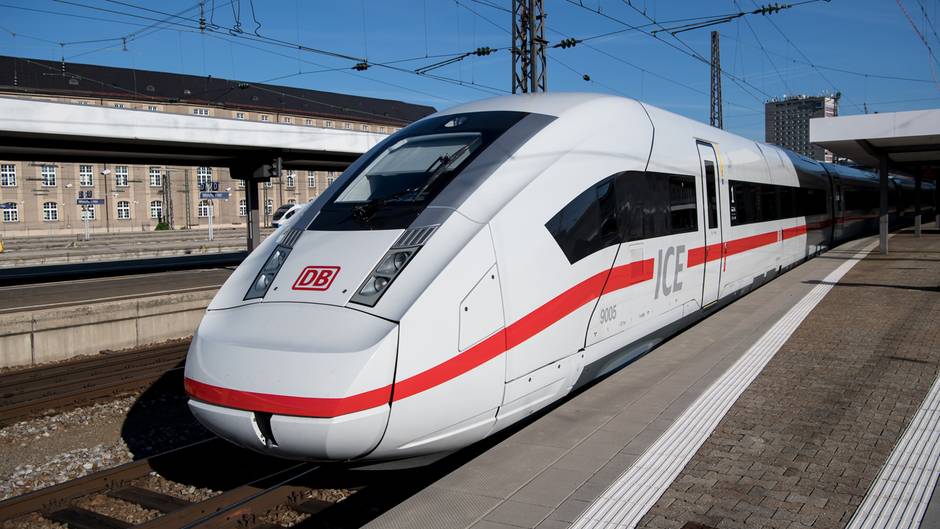
The ICE 4 will be the backbone of the Deutsche Bahn's future long-distance network. In May 2011, the German national railway company concluded a framework agreement with Siemens Mobility for up to 300 trainsets. It is the largest train contract that Siemens has ever won in its nearly 170 years of corporate history.
In the initial phase, 130 ICE4-type trains have been ordered and beginning in 2017 they will replace the Intercity and Eurocity fleets put into operation between 1971 and 1991. At a later time, it is planned to replace ICE 1 and ICE 2 vehicles. The ICE 4 will then be responsible for roughly 70 percent of Deutsche Bahn's interurban transport revenue.
The ICE 4 sets new standards in intercity traffic. A unique train concept has been developed, that means it can be individually adapted to the requirements of various transport tasks. The modular drive concept is based on independent Powercars with identical traction technology, resulting in more flexibility than ever before. High operational availability is guaranteed by a large number of reliable systems with high redundancy.
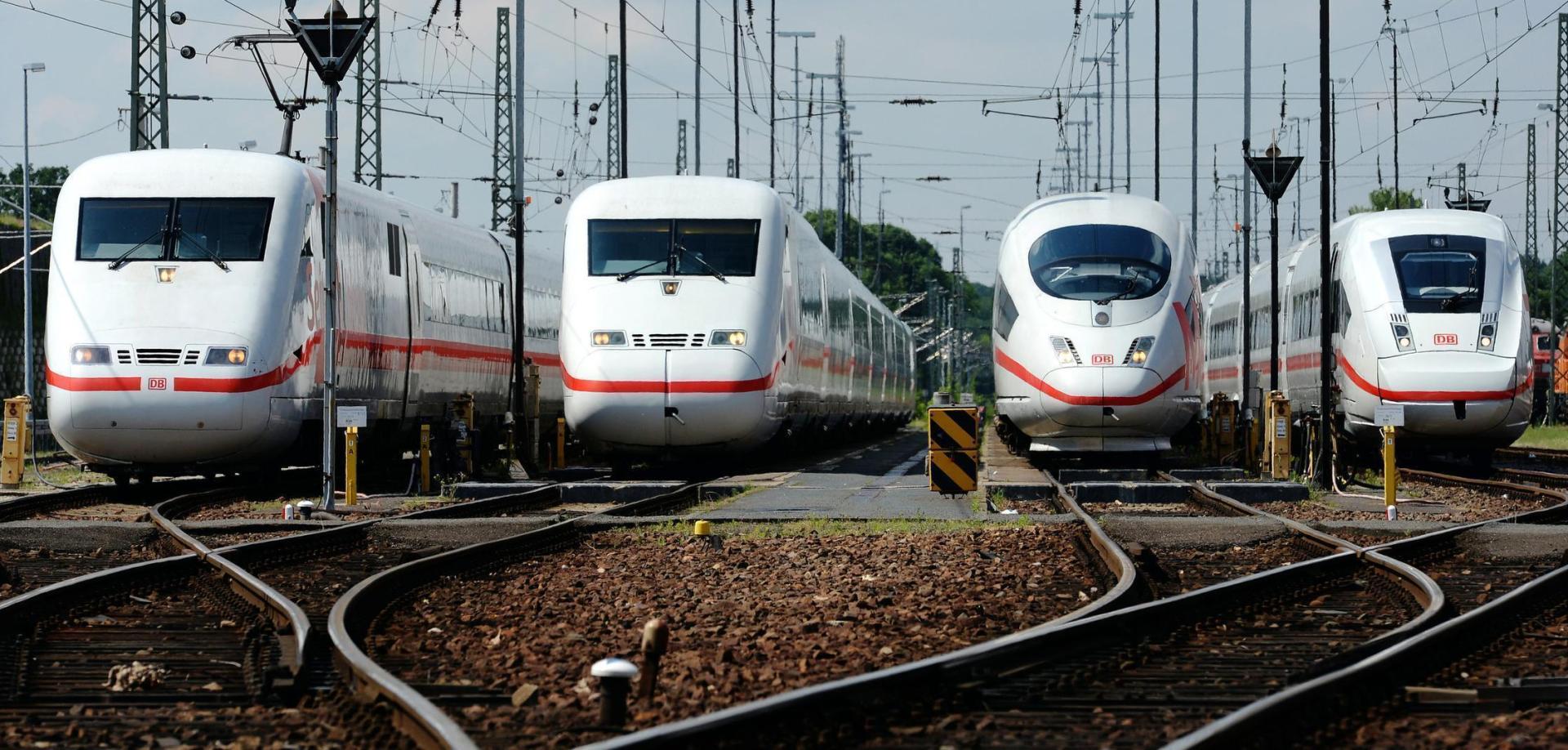
25 Jahre ICE - ICE 1 to ICE 4
(GERMANY OUT) 02.06.2016, DEU, 14055 Berlin, Grunewald, Festakt 25 Jahre ICE, Fahrzeugparade aller vier Generationen des ICE, DB Fernverkehr Parade InterCityExpress, v.l.: ICE 1: 401 001-3 (Siemens/Krauss-Maffei 1989, NVR: 93 80 5401 001-3 D-DB, Triebkopf), ICE 2: 808 010-3, Baureihe 402 (ABB Daimler-Benz Transportation 1997, NVR: 93 80 5808 010-3 D-DB, Steuerwagen), ICE 3: 403 020-1, Baureihe 403 (ABB Daimler-Benz Transportation 2000, NVR: 93 80 5403 020-1 D-DB, 1. Bauserie, Tz 320), ICE 4: Baureihe 412 Siemens Mobility, NVR: 93 80 5812 002-4, Endwagen 2. Klasse mit Fuehrerstand, nicht angetrieben, Tz 9002, Projektname ICx, Vorserienzug)!

Linienzugbeeinflussung (or LZB) is a cab signalling and train protection system used on selected German and Austrian railway lines as well as the AVE in Spain. In Germany, the system is mandatory on all lines where trains exceed speeds of 160 km/h (200 km/h in Spain), but it is also used on some slower lines to increase capacity. The German Linienzugbeeinflussung translates to continuous train control, literally: linear train influencing. It is also called linienförmige Zugbeeinflussung.

The first prototype system was developed by German Federal Railways in conjunction with Siemens and tested in 1963. It was installed in Class 103 locomotives (pictures below) and presented in 1965 with 200 km/h runs on trains to the International Exhibition in Munich. From this Siemens developed the LZB 100 system and introduced it on the Munich-Augsburg-Donawörth and Hanover-Celle-Uelzen lines, all in Class 103 locomotives. The system was overlaid on the existing signal system. All trains would obey the standard signals, but LZB equipped trains could run faster than normal as long as the track was clear ahead for a suffucient distance. LZB 100 could display up to 5 km in advance.
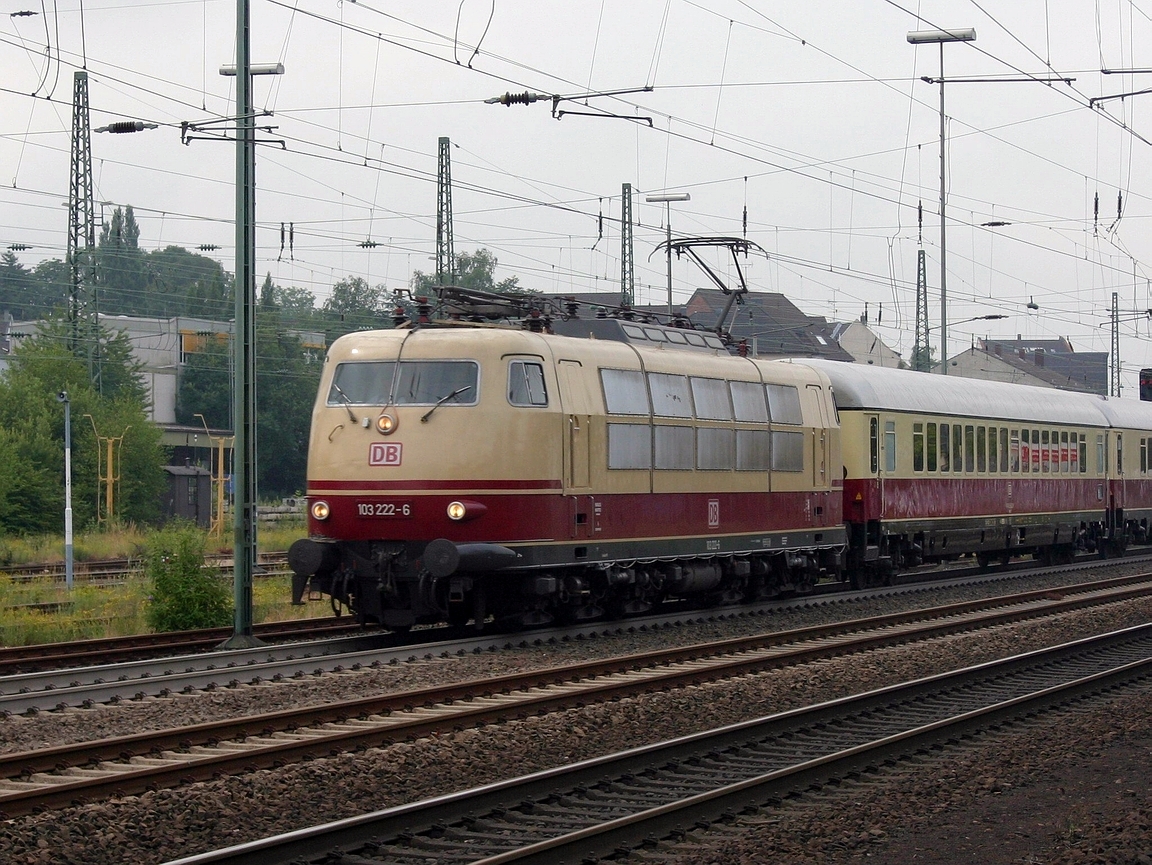
By the late 1970s, with the development of microprocessors, the 2-out-of-3 computers could be applied to on-board equipment. Siemens and SEL jointly developed the LZB 80 on-board system and equipped all locomotives and trains that travel over 160 km/h plus some heavy haul locomotives. By 1991, Germany replaced all LZB 100 equipment with LZB 80/L 72.

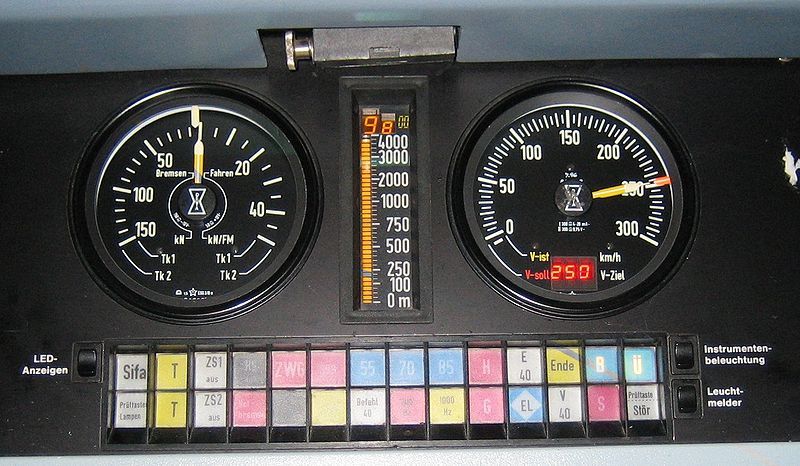 |
|
The system has spread to other countries. The Spanish equipped their first high-speed line, operating at 300 km/h, with LZB. It opened in 1992 and connects Madrid, Cordoba, and Seville. In 1987 the Austrian railways decided to introduce LZB, and with the 23 May 1993 timetable change introduced Euro City trains running 200 km/h on a 25 km long section of the Westbahn between Linz and Wels.
|
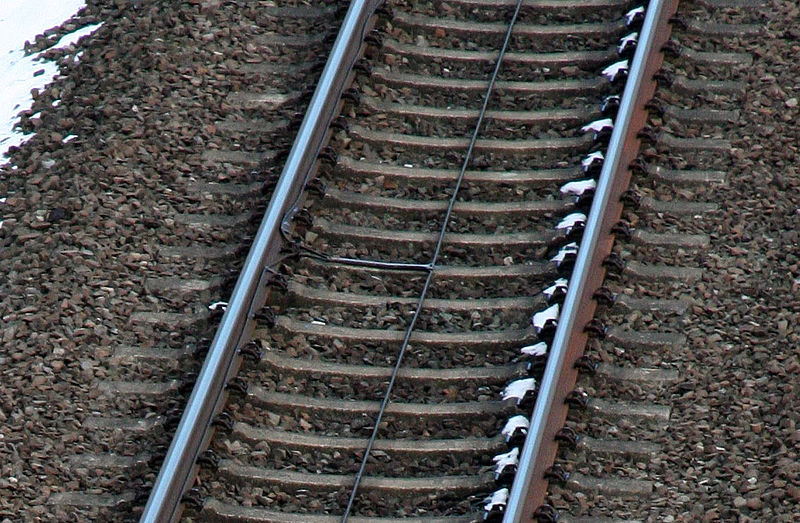 |
The LZB control center communicates with the train using conductor cable loops. Loops can be as short as 50 meters long, as used at the entrance and exit to LZB controlled track, or as long as 12.7 km. Where the loops are longer than 100 m they are crossed every 100 m. At the crossing the signal phase angle is changed by 180° reducing electrical interference between the track and the train as well as long-distance radiation of the signal. The train detects this crossing and uses it to help determine its position. Longer loops are generally fed from the middle rather than an end. |
One disadvantage of very long loops is that any break in the cable will disable LZB transmission for the entire section, up to 12.7 km. Thus, newer LZB installations, including all high-speed lines, break the cable loops into 300 m physical cables. Each cable is fed from a repeater, and all of the cables in a section will transmit the same information.

The core of the LZB route center, or central controller, consists of a 2-of-3 computer system with two computers connected to the outputs and an extra for standby. Each computer has its own power supply and is in its own frame. All 3 computers receive and process inputs and interchange their outputs and important intermediate results. If one disagrees it is disabled and the standby computer takes its place.
The computers are programmed with the fixed information from the route such as speed limits, gradients, and the location of block boundaries, switches, and signals. They are linked by LAN or cables to the interlocking system from which they receive indications of switch positions, signal indications, and track circuit or axle counter occupancy. Finally, the route center's computers communicates with controlled trains via. the cable loops previously described.
The main task of LZB is signalling to the train the speed and distance it is allowed to travel. It does this by transmitting periodic call telegrams to each train one to five times per second, depdending on the number of trains present. Four fields in the call telegram are particularly relevant:
The target speed and location are used to display the target speed and distance to the driver. The train's permitted speed is calculated using the trains braking curve, which can vary by train type, and the XG location, which is the distance from the start of the 100 m zone that is used to address the train. If the train is approaching a red signal or the beginning of an occupied block the location will match the location of the signal or block boundary. The on-board equipment will calculate the permitted speed at any point so that the train, decelerating at the deceleration indicated by its braking curve, will stop by the stopping point.
A train will have a parabolic braking curve as follows:

where:
Where a train is approaching a speed restriction the control center will transmit a packet with an XG location set to a point behind the speed restriction such that a train, decelerating based on its braking curve, will arrive at the correct speed at the start of the speed restriction. This, as well as deceleration to zero speed, is illustraded with the green line in the "Permitted and supervised speed calculation" figure.
Permitted and supervised speed calculation

ICE full-service braking and LZB deceleration
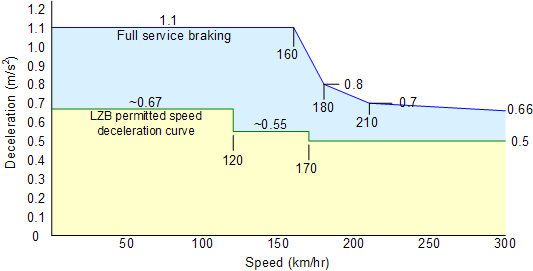
About 1700 m before the end of the LZB controlled section the central controller will send a telegram to announce the end of LZB control. The train will flash the "ENDE" light which the driver must acknowledge within 10 seconds. The display will normally give the distance and target speed at the end of the controlled section, which will depend on the signal at that point. When the train reaches the end of LZB control the "Ü" and "ENDE" lights go off and the conventional INDUSI (or PZB) system takes over automatic train protection.
Special conditions not covered by the full LZB system or failures can put LZB into one of the special operating modes. Crossover to opposite track
As a train approaches a crossover to a normally opposite direction track the display will flash the "E/40" light. The driver confirms the indication and the permitted speed drops following the braking curve to 40 km/h. When the crossover section is reached the displays are switched off and the driver can proceed through the crossover at 40 km/h.
German signaling systems have a "drive by sight" signal that consists of 3 white lights forming a triangle with one light at the top. This signal, labeled "Zs 101", is placed with a fixed line side signal and, when lighted, permits the driver to pass a fixed red or defective signal and drive by sight to the end of the interlocking no faster than 40 km/h. When approaching such a signal in LZB territory the "E/40" light will be lit until 250 m before the signal, then the "E/40" will go dark and "V40" will flash. The "V40" signal indicates the ability to drive by sight.
If data exchange is interrupted, the trains distance measurement system fails, or the train fails to detect 4 or more cable transposition points the LZB system will go into a failure state. It will light the "Stör" indicator and then flash "Ü". The driver must acknowledge the indications within 10 seconds. The driver must slow the train to no more than 85 km/h or lower; the exact speed depends on the backup signaling system in place.

